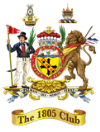Bodmin
Bodmin is replete with beautiful and fascinating buildings such as Berry Tower, Victoria Barracks and The Shire Hall and is a great place to explore if you keep your eyes open! One of the oldest towns in Cornwall, and the only large Cornish settlement recorded in the Domesday Book, Bodmin is also home to St Petroc’s Church which dates from the 15th Century and was, until the building of Truro Cathedral, the largest church in Cornwall.
There is also the famous Bodmin Jail, the first in the UK to offer individual cells for prisoners and site of many executions. During the First World War the prison held the Domesday Book and the Crown Jewels of the United Kingdom.
Lieutenant Lapenotiere is believed to have changed horses at The Kings Arms which is no longer in existence but a plaque commemorating his visit is situated in Mount Folly Square on a stone wall to the left of the steps leading up from the street to Shire Hall.
There is also the famous Bodmin Jail, the first in the UK to offer individual cells for prisoners and site of many executions. During the First World War the prison held the Domesday Book and the Crown Jewels of the United Kingdom.
Lieutenant Lapenotiere is believed to have changed horses at The Kings Arms which is no longer in existence but a plaque commemorating his visit is situated in Mount Folly Square on a stone wall to the left of the steps leading up from the street to Shire Hall.

Colourful Bodmin
Image © Copyright Ian Gregory
Bodmin Moor, Temple, Blisland, Altarnun, Five Lanes
A wild and rugged stage of The Trafalgar Way now takes you across Bodmin Moor - an Area of Outstanding Natural Beauty with breathtaking views and many exceptional features such as Coliford Lake and Brown Willy (Cornwall’s highest peak at 1378 feet). Dominated by granite tors the moor also has deep river valleys with rich oak woodland. This is a landscape which has inspired writers and poets and is rich in local folklore and legend. Go wandering and see what you can find - but stay safe, check the weather and inform someone of what you are doing!
There are many picturesque and fascinating villages on Bodmin Moor such as Temple with its church dating back to 1120, Trewint (meaning ‘windy farm’) with its museum of Methodism, Blisland with its beautiful inn and Altarnun with its church of St Nonna, known as ‘The Cathedral of the Moor”. There’s also Five Lanes with its old coaching inn, The Kings Head, and acoss the Moor, Minions, where you may see sheep and ponies wandering through the high street.
There are many picturesque and fascinating villages on Bodmin Moor such as Temple with its church dating back to 1120, Trewint (meaning ‘windy farm’) with its museum of Methodism, Blisland with its beautiful inn and Altarnun with its church of St Nonna, known as ‘The Cathedral of the Moor”. There’s also Five Lanes with its old coaching inn, The Kings Head, and acoss the Moor, Minions, where you may see sheep and ponies wandering through the high street.
Of course Bodmin is also the home of The Jamaica Inn - made famous by Daphne du Maurier’s story of smugglers. From here you can look west towards Bodmin Moor.
Derelict engine houses pepper the moor, left over from the 19th Century copper boom, and there are arresting natural stone formations such as the Cheesewring and ancient man-made stone features like The Hurlers, just west of Minions.
Derelict engine houses pepper the moor, left over from the 19th Century copper boom, and there are arresting natural stone formations such as the Cheesewring and ancient man-made stone features like The Hurlers, just west of Minions.

The route to Launceston
Map image © Cassini Publishing Ltd.
The route through Polyphant
The posting manual, Paterson's Roads of 1803, tells us that the coach route south from Launceston passed by Hick's Mill and "Trerethick Bridge" before arriving at Trewint.
On today's roadmap, and in reverse, this means the route heads north-east from the King's Head at Five Lanes and follows little lanes to cross the pretty stone multispan bridge (which is today a grade II listed monument) across Penpont Water, then up the hill into Polyphant before descending towards Launceston via Hick's Mill. Check out our interactive map for more clarity about this assumed route.






